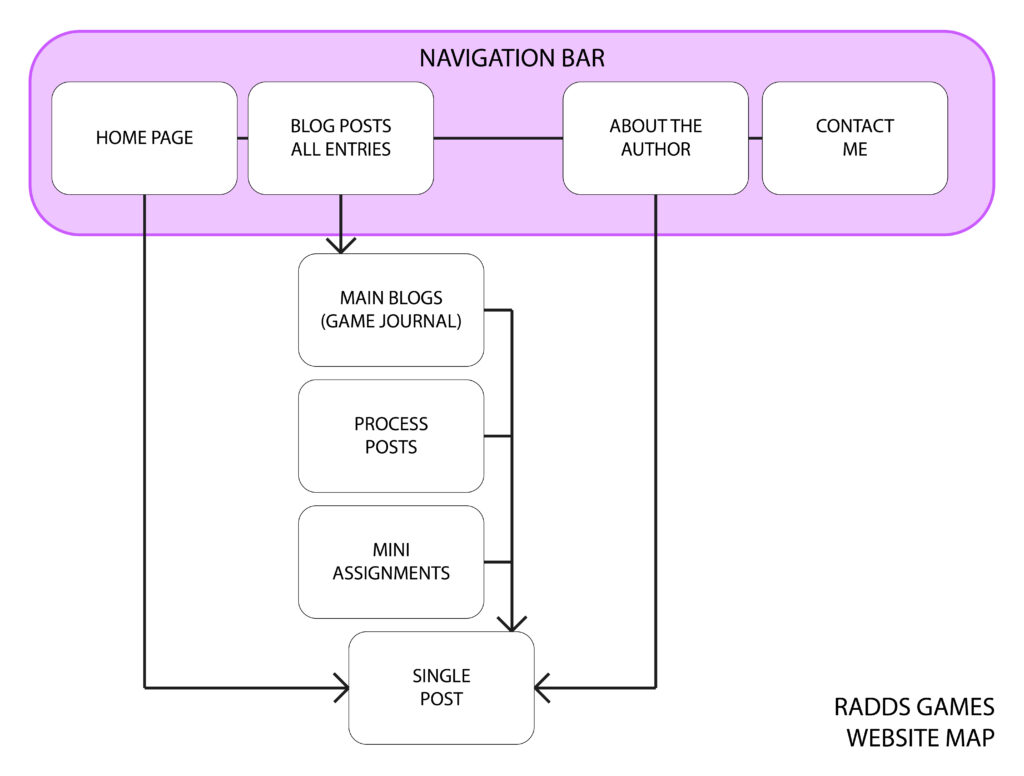
Week 3 – Process Post – Website Map


To set up this website, I followed the recommended instructions linked to the POSIEL web page and purchased a standard student domain (the personal package). POSIEL start-up-guide: https://posiel.com/docs/hosting-setup/ I chose to register a domain name which included parts of my name as I wanted the blog to be personal, however, I did not create it […]
To set up this website, I followed the recommended instructions linked to the POSIEL web page and purchased a standard student domain (the personal package).
POSIEL start-up-guide: https://posiel.com/docs/hosting-setup/
I chose to register a domain name which included parts of my name as I wanted the blog to be personal, however, I did not create it under my first and last name as I already own that domain and am holding onto it to create an online portfolio for my freelance work.
The registration was clean and easy; I’ve never used this hosting platform, but the UI was easy to understand and follow along with. Once I was able to access the CPanel, I selected WordPress and proceed with the installation. The installation was standard and I simply followed all the prompts to setup a fresh WordPress site. Having worked with WordPress in the past, I already had an idea of which plugins I planned to install – primarily Elementor Pro.
Link to Elementor Pro: https://elementor.com/
Elementor is a plugin that provides drag-and-drop design functionality with an impressive suite of components to work with. Furthermore, the pro version of this plugin is reasonably priced and allows full creative control over your elements and the overall design – essentially, it feels as I have full control over my pages, as if I was creating them from scratch using html/css/js, however, I can create pages in a fraction of the time. For now this was the only plugin I decided to install. Depending on how this website progresses, I may begin installing plugins that enhance the component suit of WordPress, however, this doesn’t feel necessary yet – the default components satisfy my current design needs.
Getting started with Elementor, you are able to choose a starting kit (starting theme). I opted to go with a blog setup as it felt appropriate, however, wanted to select the most bare-bones kit so that moving forward I have the most create control, and so I won’t find myself deleting unnecessary components from the website. Using one of the basic kits allows me to work with a clean slate and makes it easy to translate my wireframes from illustrator to the live website. Furthermore, I started doing some research into blog inspiration and possible color palettes.
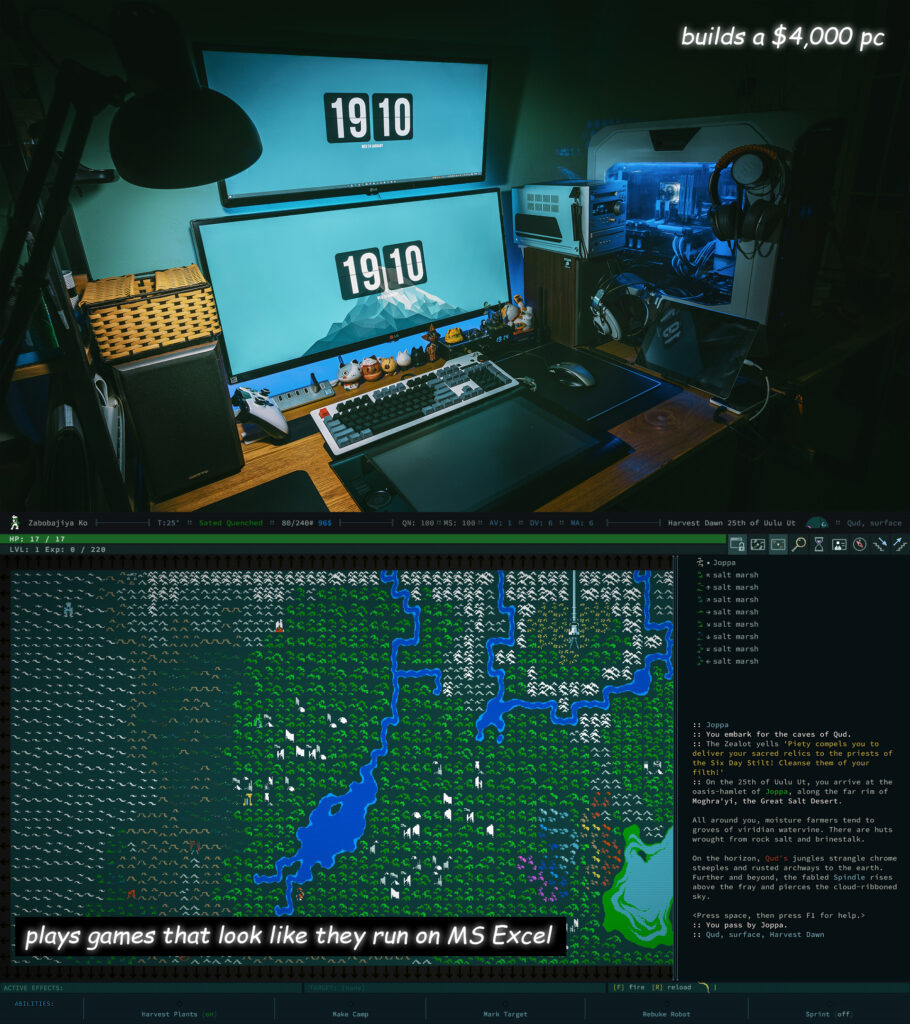
What do you get when you combine Quake, Vampire Survivors, and a fascination for Vlad the Impaler? Impaler (the game) is an indie roguelite, arena survival, boomer shooter running on a custom engine; where you’re tasked to clear waves of oncoming monsters in a large cathedral room – doing your best to survive each onslaught […]
What do you get when you combine Quake, Vampire Survivors, and a fascination for Vlad the Impaler? Impaler (the game) is an indie roguelite, arena survival, boomer shooter running on a custom engine; where you’re tasked to clear waves of oncoming monsters in a large cathedral room – doing your best to survive each onslaught thrown your way. The game currently sits at a price point of $3.89 CAD and is created by a small studio known as Apptivus. It seems to be their only PC title so far – their prior endeavors being in the physical toy and mobile app space.
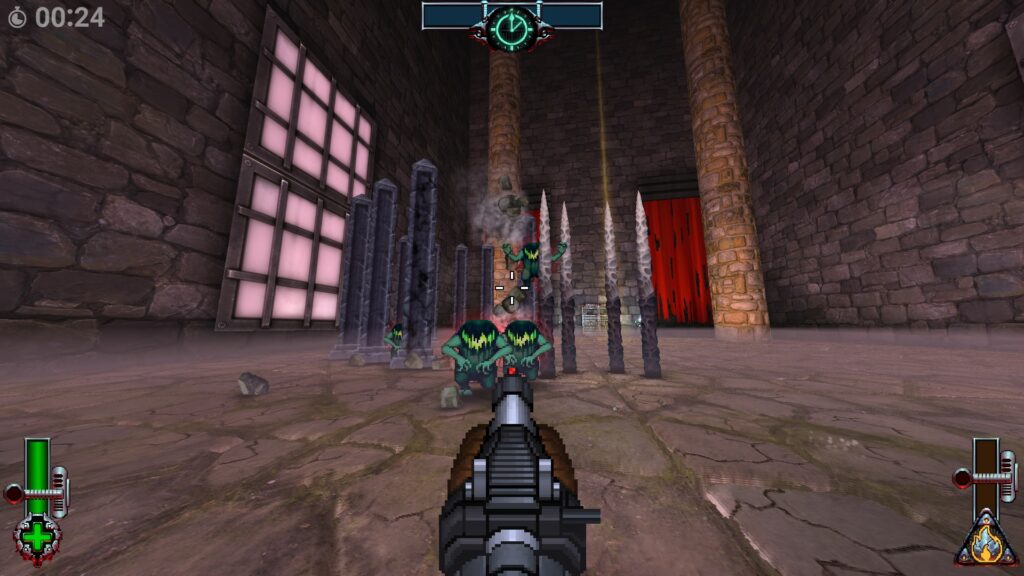
The gameplay loop is simple, players are given the choice of a primary starting weapon, along with the default secondary weapon known as “the Impaler” – although I find this weapon functions more as the player’s primary weapon as the core mechanics revolve around its projectiles. The first time you play the game, you can only choose the first weapon, the Perforator, which functions as an SMG; so, I selected this and began the brief tutorial.
Primary weapons function intuitively, SMGs/ARs shoot a stream of bullets, shotguns shoot in slow bursts, launchers shoot even slower with more damaging projectiles and the single sword allows you to melee nearby enemies while also firing a slash of energy to hit anything at a distance. All these attacks are bound to the left mouse button by default.
Where the game shines, however, is the Impaler. Players can hold down the right mouse button to show a targeting circle and press the left mouse button to create a spike that shoots up from the ground, impaling anything unfortunate enough to be above that location. This weapon can also be used defensively, as the spikes persist in the arena and can be used to form obstacles for the enemies. Furthermore, they can be used to launch the player into the air allowing for vertical navigation throughout the arena.
While there is no reloading, both the primary and secondary weapons have an overheat meter, which builds with each subsequent shot and will briefly prevent the player from firing if filled.
With a trusty weapon selected, players are thrown into the rectangular arena where a wave of monsters spawns, along with various environmental obstacles which can be destroyed and pushed around. Furthermore, each level spawns three “goblet” which can be pushed towards a glowing circle; exploding into coins and occasionally health for the player to collect. Monster kills drop coins for the player and small bundles of health if killed with the Impaler. Once all monsters are killed, the room despawns all the obstacles and provides players with coins or health – the coins only spawning if the player completes the level with a full health bar. You then step into the center of the arena and the loop starts again with a new layout and a new set of enemies – however, if you have enough coins, you are given a choice of two upgrades prior to starting the stage.
The upgrades appear in seven categories:
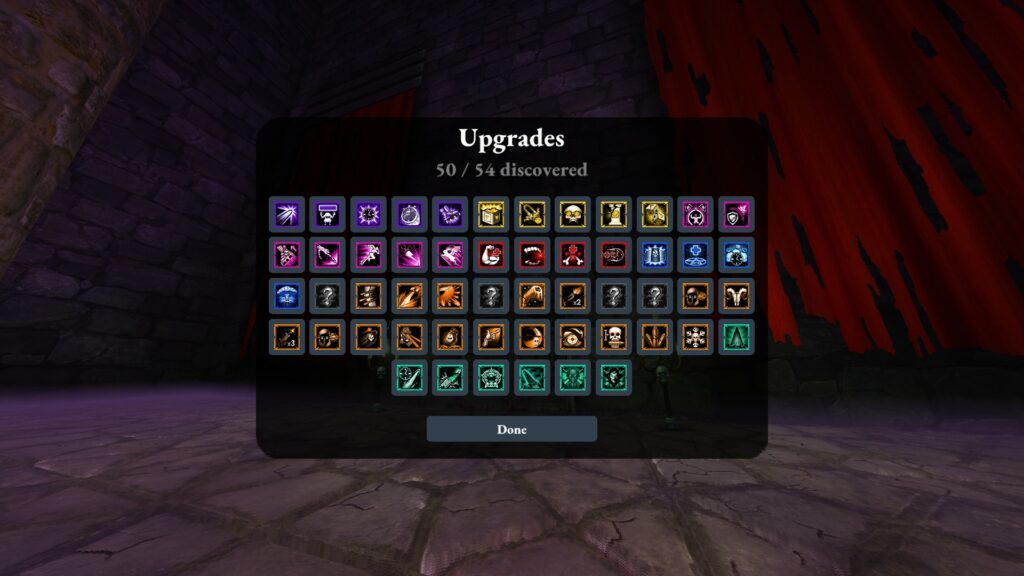
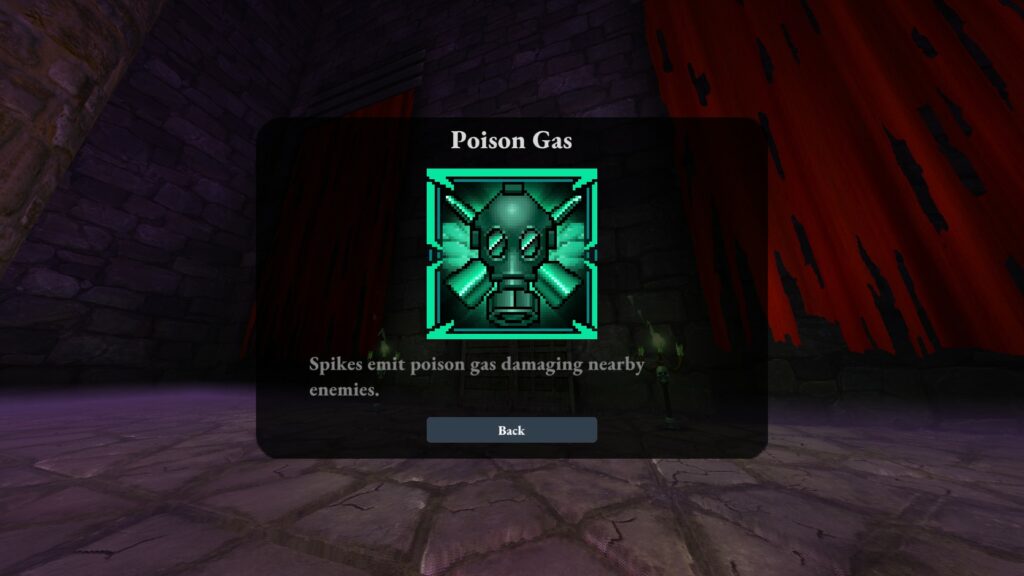
Weapons are unlocked by completing various challenges such as achieving a total number of kills, achieving a number of kills by impaling enemies or killing a certain number of enemies with environmental hazards. There are eight total weapons:
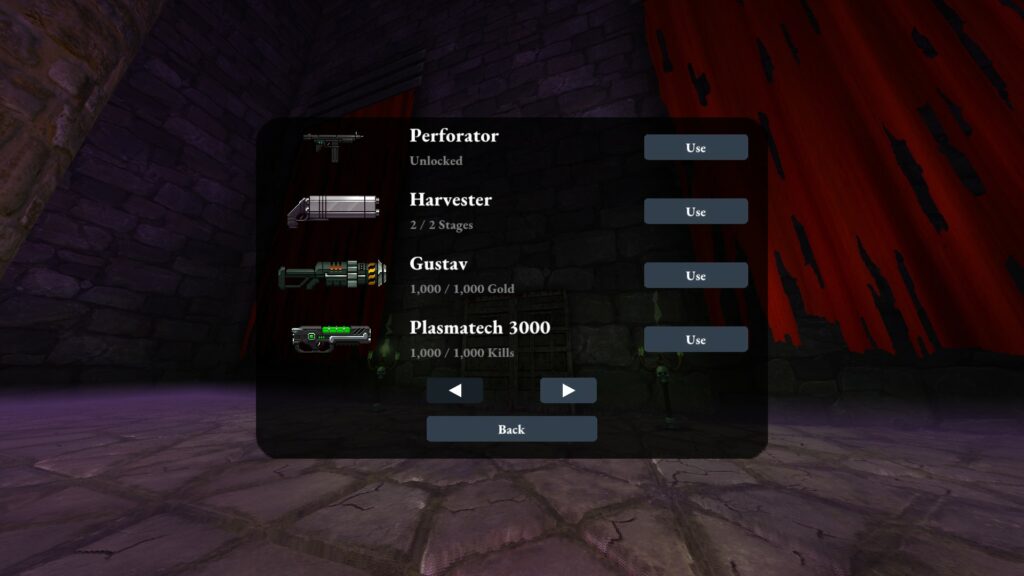
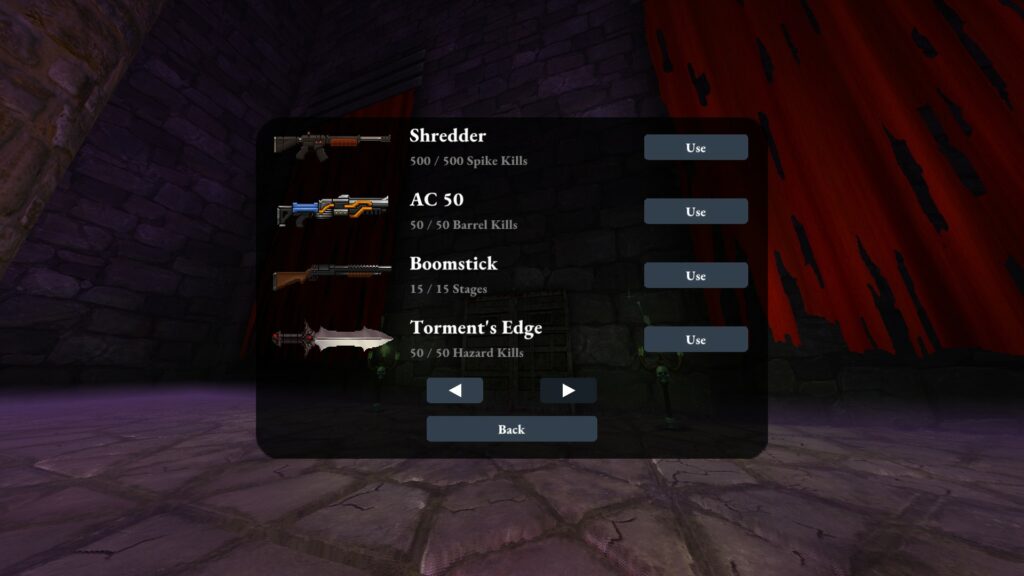
Starting off my first run, I immediately appreciated the simplicity of the tutorial. The game goes over basic mechanics such as shooting your primary weapon and impaling enemies. It covers the stomp attack that occurs when you land after a high jump and details that enemies can also be killed by jumping on their heads. And lastly, it details that goblets can be pushed into rings of light by walking into them to launch them into a certain direction. With the basics covered, the game put me right into the action.
The UI is simple yet effective, it hardly takes up any screen space, detailing the player’s health, overheat status and number of coins collected. Below the coin counter there is also a meter showing the player how close they are to their next upgrade.
Movement feels crisp and responsive, a must for a fast-paced boomer shooter. Players can strafe and bunny hop to increase their momentum, double jump to avoid obstacles and even rocket-jump – or spike jump in this case – by shooting the Impaler directly below your feet. Successfully initiating a spike jump will allow release an AOE burst of damage around the player when they land.
My first run felt relatively easy, enemies spawned in cages, giving players a moment to plan their next move before being rushed. Each stage introduced new enemies with various mechanics – some of the basic enemies rushed me and were easily disposed with the Impaler, while other enemies were airborne or atop tall pillars requiring me to spike jump and get in a favorable position to take them out with the primary weapon. While the entire game takes place in a single room, I appreciated the variety of level layouts as each new stage removed the previous obstacles and set up new ones. As the game progressed, environmental hazards began to appear such as sawblades moving from one end to the other on one axis, or laser beams moving across the arena in two axes.
Upgrades felt plentiful, having a choice provided after almost each stage. I decided to dump all my upgrades into the Impaler spikes – finding that survivability boosts didn’t feel necessary. Similarly, I found myself hardly strafing nor bunny hopping as basic movement combined with spike jumps were more than enough to survive. This strategy ultimately paid off as I managed to get to the final boss and beat it.
The final boss itself – a massive floating skull stationary in the middle of the arena – felt lackluster. The arena setup was fairly open allowing me to freely fly around the arena with spike jumps and avoid all enemies. Furthermore, waves of enemies kept spawning, allowing me to kite them and impale them in groups to infinitely refill my health with their drops. Upon firing at the boss, I realized there weren’t any damage indicators, instead a graphic bubble floated above its head instructing me to stomp on it. Using the various jump pads in the arena, I quickly caught on and began my aerial assault – taking me back to the days roleplaying a certain Italian plumber stomping on unexpecting turtles. Each successful stomp spawned explosive barrels around the boss, which needed to be destroyed prior to the next stomp. After four or five stomps, the boss was defeated, and a victory screen appeared, notifying me that a new difficulty had been unlocked.
There wasn’t much strategy involved in my first run, I hardly felt overwhelmed and allowed myself to grasp the various mechanics while getting used to movement. It was only when I began playing on hard that I felt the game truly required a mastery of all it’s mechanics. Starting the game anew, I chose a different weapon, the Harvester shotgun pistol. Truthfully, this felt like a downgrade from the default weapon, thus, I once again relied primarily on the Impaler. I made it half-way through a full run before eventually getting overwhelmed and dying.
Nonetheless, I started to pick up on more of the game’s mechanics. Previously acquired upgrades were now shown in detail, while ones that I had yet to choose were still a mystery – this along with the weapon unlocks now made the progression clear. The more runs I played; the more planning would be available for future runs as I now knew what each upgrade provided; this allowed for careful selection to create synergies. I noticed that there were variations of the goblets that would spawn, some being basic golden goblets, others having a cross on them, and the third variant featured a demonic face – despite noticing this, I had yet to understand their varying significance.
I tried a few more runs on hard, each being unsuccessful; however, as weapon unlocks came easily, they allowed me to experiment with the armory and figure out which best suited my playstyle.
Ultimately, I’d argue that the most effective weapons were the fully automatic ones – the Perforator, the Plasmatech, and the Shredder as they didn’t have a long wait time between shots and allowed me to take out flying enemies from a distance. The last being the most important aspect of these weapons, as I found the flying demons and the enemies positioned atop pillars to most dangerous and prioritized them above all the others. The shotguns required putting myself in positions where the danger outweighs the potential damage. Similarly, while launcher allowed me to target enemies at a distance, the rate of fire was far too slow – even with upgrades – and often got me overwhelmed and overrun.
Nonetheless, like any good roguelike/roguelite, each subsequent run I noticed myself getting better – mechanically and strategically. Emergent mechanics became clear, I was now able to time my spike jumps in combination, shooting the next spike inches ahead of my position and just before landing to launch myself once more and stay airborne. I learned the significance of the goblets – basic ones would explode into coins when pushed to their target, cross goblets exploded into health and coins, and most importantly, the I noticed the demon goblets would suck up any coins or health pickups in the arena, removing them from play. With this new knowledge, prioritization played an even more important role. Previously, if I felt overwhelmed by monsters I could ignore the goblet in play – sacrificing some gold to ensure my survival. Now, I would need to effectively kite enemies while pushing demon goblets onto their targets to ensure my run progression isn’t halted – more importantly, to ensure my health pickups weren’t being removed from the arena.
The more I played, the more I found myself getting into the “dance” of floating around the arena with quick reactions. I later discovered that once you kick a goblet, you can shoot it while it’s midair to push it even further – this allowed me to quickly dispatch goblets and turn my attention to the oncoming enemies. Even later, I learned that I could impale a goblet with a spike to get it airborne, then shoot it to further push it into that direction. I no longer needed to run up to the goblets to begin moving them around – two clicks from across the arena had the same effect.
After about five hours, I felt as if I was able to effectively combine all available mechanics to weave my way through enemies, collect the most amount of coins and consistently avoid damage. My previous point opinion on weapon types held up as I successfully completed a full run – and beat the final boss on hard.
This now unlocked the nightmare difficulty, which I gave a few tries, however, ultimately the artificial difficulty of this mode took away from the fun. Basic enemies became bullet sponges, while the rest of the mechanics worked the same. While I’m sure it’s still possible to beat the game on nightmare with a strong set of upgrades, it felt like a chore compared to the previous difficulty.
One mechanic I hadn’t discussed was the leaderboard system. The game counts scores based on the types of kills a player gets throughout their run, multiplied by their chosen difficulty. Only a few hours into the game I found myself in the top 500 players (out of 6615 total players) with my successful run on hard. The gap between my current position and being in the top 100 is quite small, and I believe I can reach a spot in the top 100 with a win on nightmare.
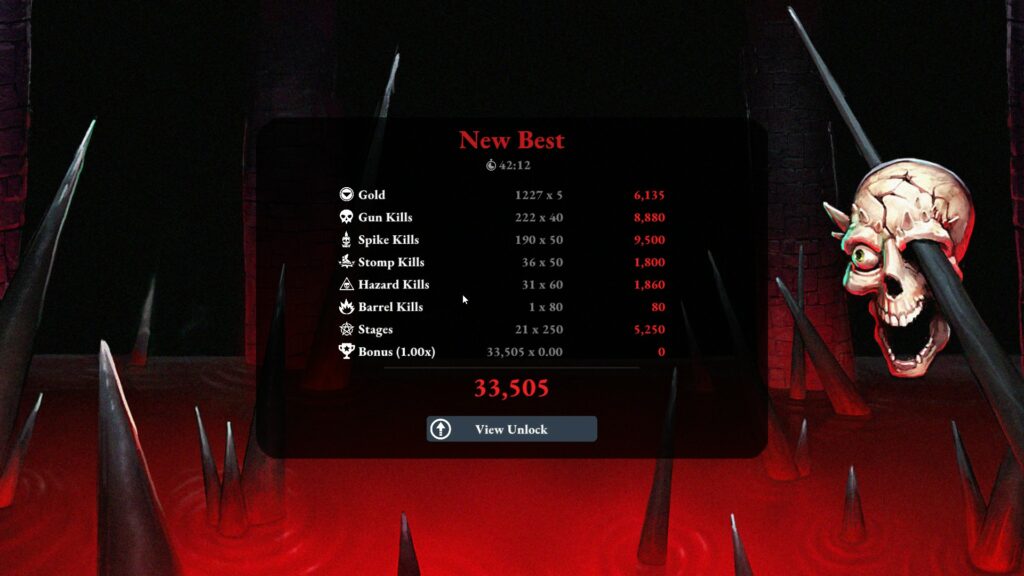
Reflecting on the game objectively, I do hold some criticism. As previously mentioned, the final boss feels far too easy when compared to some of the normal stages that must be completed to get there. It relies on overwhelming the player with basic enemies (that can be dispatched easily) and takes the focus away from the movement required to survive regular stages – and the movement is arguably the best part of this game. A missed opportunity in my opinion. Furthermore, the environmental hazards (not obstacles) seem far too damaging. I could be 30 minutes into a run, only to find my health bar fully depleted by standing in a laser beam for a fraction of a second. Lastly, the leaderboard system unnecessary as scoring seems slightly arbitrary with the player relying on random upgrades. I wouldn’t say I felt a sense of accomplishment seeing my position climb as in other games like Devil Daggers or Hyper Demon. Lastly, while the graphical style is fitting, the 2D sprites of enemies which always face the player makes the stomping mechanic feel off – often times missing by an inch due to lack of depth of enemy models and hitboxes.
Overall, this game was a pleasant surprise. For such a small price the potential play time and fun is unmatched. Although minimal, the game weaves its mechanics into a beautiful combination making the player feel like the demon slayers of classic shooters – bobbing and weaving between monsters and soaring through to skies to demolish enemies from above. The discovery of emergent mechanics combined with the lack of instructions allows for a sense of discovery and constant improvement. The roguelike elements with random upgrades certainly encourage replayability, however, feel overshadowed by the core mechanic of the self-titled Impaler gun. The game truly shines from its use of movement and spike jumping and feels like a mechanical delight. I would recommend Impaler to any fans of doomer shooters.
This week I initiated a conversation with a stranger at the gym while using the high row machine. There was an another man sitting across from me on the leg extension, who I’ve see regularly. This is an older man who’s walking around with solid mass and a well-rounded physique; someone who you could tell […]

This week I initiated a conversation with a stranger at the gym while using the high row machine. There was an another man sitting across from me on the leg extension, who I’ve see regularly. This is an older man who’s walking around with solid mass and a well-rounded physique; someone who you could tell has dedicated themselves to the gym decades ago and has kept themselves consistent. While doing my exercise, I noticed a few glances from the man and decided to strike up a conversation between sets. Once I had finished my set, I got up, gave him a greeting and asked if he could critique my form – to which he agreed. The man watched me throughout my next set and pointed out the I’m turning my head to look into the mirror to the left. He further explained that I should avoid doing so and look head-on to avoid any strains or injuries. Once the set was over he further commented that my form was correct and that I’m doing my reps with full range of motion, adding in some words of encouragement. I thanked him for the advice and continued our conversation. From here we introduced each ourselves and made small talk, conversating about how long he’s been working out and such, then went our separate ways to continue out routines.
The interaction was pleasant and felt incredibly genuine. It was apparent that the man was passionate about bodybuilding and was excited to share his knowledge. Throughout the brief conversation you could really get a sense of his personality and I appreciated the constructive criticism. Compared to online interactions, it definitely felt like I was making a genuine connection with random individual; while through social media and video games random interactions feel surface level. Of course context matters; in a multiplayer video game you’re not trying to get to know your teammates, rather you’re attempting to effectively communicate and coordinate – or banter. Being that these interactions are anonymous, there’s less of the genuineness and connection yet they tend to be more direct. To contrast this, often times I find myself playing cooperative games with friends, using Discord to communicate. In these situations, I would argue that these online interactions don’t differ from face-to-face ones as we’re all close friends and the conversations are no different than those we have when we’re all getting together.